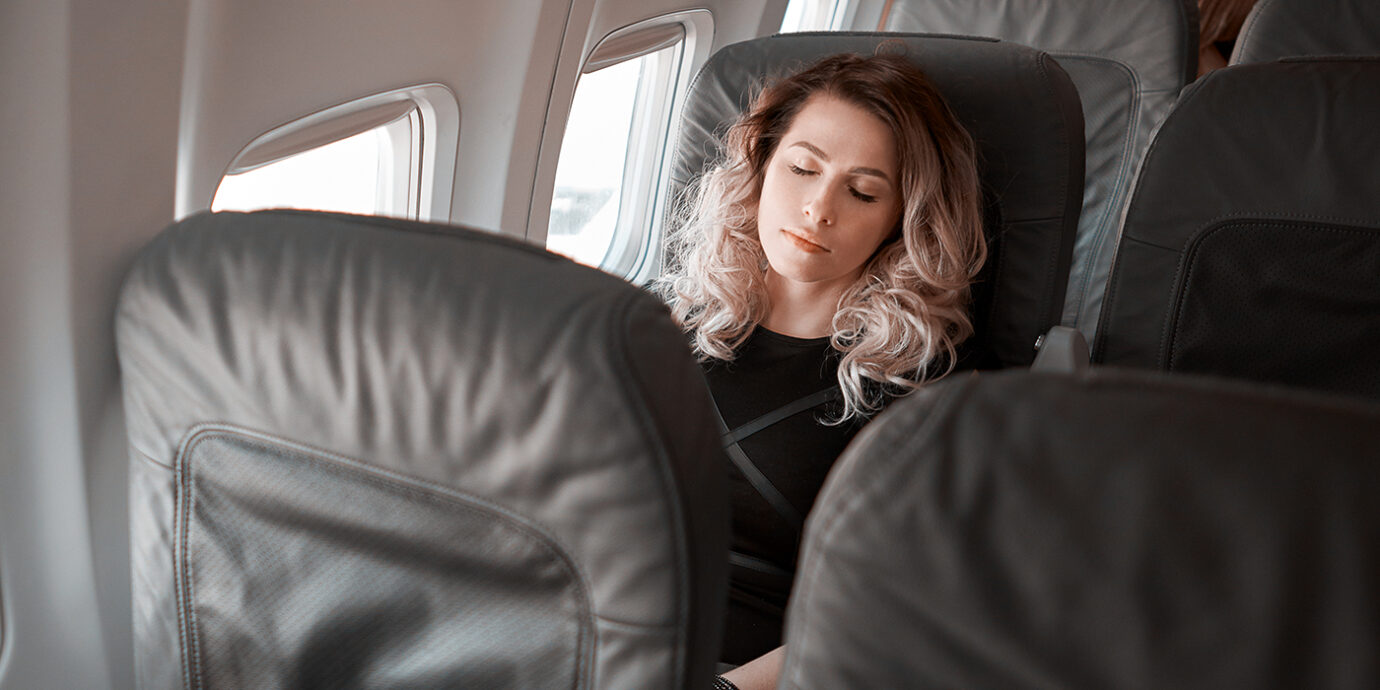
How to Sleep On a Plane (For Real): Tips for Snoozing at 30,000 Feet
The cabin lights dim. Your travel pillow is comfortably wrapped around your neck, blanket pulled up to your chin. Earplugs, sleep mask, and compression socks—all on and ready to go. But 20 minutes pass and you’re still awake. A flight attendant walks down the aisle and accidentally sideswipes your shoulder. A baby starts fussing. Then the captain announces that you’re about to hit turbulence.
So much for sleeping on your long-haul flight.
For many travelers, it’s an all-too-familiar scenario. The challenge of getting a restful night’s sleep while confined to an upright seat with little legroom and zero control of environmental interruptions can certainly be frustrating.
The good news: there are things you can do—before and during your flight—to increase your chances of snoozing at 30,000 feet. We can’t promise you’ll drift soundly into dreamland and wake up refreshed when the wheels hit the runway. But following our tips and advice will give you a decent shot of catching some shut-eye.
Pre-Flight Prep
Before we launch into the details, the first step is manage expectations. Be realistic and start with the mindset that even if you do everything “right,” you still may not fall asleep on the plane. Take the pressure off yourself. You’ve slogged through days tired before, and if you have to tweak your itinerary on the first day of vacation so you can nap back at the hotel, it isn’t the end of the world.
With that out of the way, let’s begin. You likely know that your body functions on a 24-hour cycle of sleeping and wakefulness, called your circadian rhythm. Plenty of factors can throw it off—hopping time zones is one of them. The result is dreaded jet lag.
It takes about 24 hours on average for your internal clock to shift ahead or back by one hour. That’s why you need to alter sleep times before your trip; your goal should be to get yourself as close as possible to the time in your future destination. According to the National Sleep Foundation, it’s best to start adjusting when you go to bed (and when you wake up) three to five days ahead of your trip. Consider Timeshifter, an excellent app to use in advance of your trip that slowly helps you adapt to time changes.
Changing your sleep schedule is huge, but there’s more you can do to get your body ready. When and how much you eat, drink, and exercise—particularly the evening before and the day of your flight—have a considerable impact on sleep. Avoid exercising close to bedtime the night before you leave, as doing so can prevent restful sleep. On your travel day, try to push meals to when you’ll be eating after you arrive, and watch the timing of caffeine intake. (More on eating and drinking in-flight below.) Lastly, if you’re planning to take a sleep aid on the plane, give it a test run well in advance—we can’t emphasize this enough. If it doesn’t work at all, you’ll have time to try alternatives. The most important thing is to make sure it agrees with your system and doesn’t cause any adverse reactions.
RELATED: My Under-$6 Secret Weapon for Sleeping Soundly on Any Flight—Even in the Middle Seat
Choose Your Seat and Flight Time Wisely
Picking the right seat—looking in advance at your flight’s seat configuration—is key in your sleep strategy. Depending on how long your flight is, it may be worth forking over the extra fee for a few additional inches of legroom, or choosing an aisle seat if you have long legs. Most people who are hoping to sleep on a flight opt for a window seat; if you tend to get cold, know that they can get pretty chilly in the middle of the night.
Aim for seats away from the toilets and the galley. Keep in mind that exit row and last row seats don’t recline, and bulkhead seats typically have fixed armrests, so you can forget about lying down if you’re lucky enough to score an empty seat next to you. Though reclining is hotly debated among travelers, we consider it OK to push your seat back if you ask the person behind you first as a courtesy.
As for flight times, ideally you’ll want to take an early evening flight if you’re traveling eastbound, and an early morning fight if you’re heading west.
Plan your in-flight wardrobe
A 10-hour flight doesn’t give you an automatic pass to sport your ratty college sweatpants. Comfortable jeans, a pair of polished joggers, or leggings are all good options. Believe it or not, there are no federal regulations that dictate cabin temperature other than it must be within five degrees of the cockpit. What we’re saying is that dressing in layers is a smart way to go. Think in threes: a tank top or cami, a long- or short-sleeve T-shirt depending on the season, and a warm fleece or wool pullover will do the trick. Another excellent edition is a pair of roll-up ballet flats. They stay on your feet better than slippers and rubber soles make them better for trips to the lav.
RELATED: The Very Best Airport Outfits, According to Travel Editors
Bring the Right Travel Accessories
Earplugs and a sleep mask can make or break your ability to sleep on a flight. So can a pair of travel headphones; if you’re willing to splurge, go for ones with active noise-cancelling technology. Since you can’t count on extras being doled out in economy, bringing your own travel blanket and pillow will help you get comfortable in your seat. If you aren’t a fan of donut-shaped or blow-up travel pillows, it’s worth considering a Trtl, an Amazon bestseller that wraps around your neck like a scarf. Wearing compression socks prevent your legs from swelling and cramping, which can certainly keep you awake. Since compression gear often skews dowdy, consider these preppy compression socks as a colorful alternative.
Keep Your Food and Alcohol/Caffeine Intake In Check
Everyone knows that having a big meal and then going to bed is a bad idea, yet somehow this wisdom gets lost during airplane travel. Wolfing down everything on your tray table is a recipe for indigestion and heartburn. Also, don’t forget to watch your caffeine consumption. While skipping alcohol altogether is the smartest way to go, it’s also nice to sit back and relax with a glass of wine, particularly on international flights when it’s complimentary, even in economy. It’s fine to enjoy it, but know your limits and make sure to hydrate with two glasses of water for every drink you have.
Elevate and stretch
Some carriers have economy seats with extras like footrests and adjustable headrests, but this isn’t the norm. Finding the right position can feel next to impossible sometimes, and there’s no one solution that suits all travelers. There are, however, a few practices that can help. If you need extra lumbar support and don’t have a second pillow or blanket, roll up a sweatshirt to place behind your back. Uncross your legs and prop your feet up on your personal item stowed underneath the seat in front of you to elevate them. Get up to stretch from time to time on a long flight. Also, airplane yoga is totally a thing. We don’t suggest dropping down in the aisle for downward dog, but try neck rolls, eagle arms, seated cat-cow, and, of course, deep breathing.
Mind your screen time
We admit to being in-flight entertainment bingers. We even confess to looking at airline apps in advance to plan our TV and movie lineup. With that said, if you’re serious about wanting to sleep and can exercise screen time self-control, we urge you to keep blue light exposure from laptops, tablets, and smartphones to a minimum. Adjusting the brightness and switching from color to black and white in settings helps. It’s also good seatmate etiquette.
Talk to your flight attendant
Some travelers swear by skipping cabin service altogether and going to sleep right after takeoff. If that’s your plan, consider giving flight attendants a heads up. Make sure your seatbelt is buckled and not hidden by a blanket or jacket. If there’s turbulence, flight attendants will come around to make sure they’re fastened. And if they aren’t, you’ll get woken up. Also ensure that your carry-on is fully tucked under the seat in front of you, or you’ll get a wake-up call for that, too.
Meditate
You also may wish to consider meditation apps too, like Calm and Headspace. After all, who can’t use an extra bit of Zen while traveling?
Related Stories
- The Best White Noise Machines, Sleep Apps, and YouTube Videos for Great Sleep Anywhere
- The Products You Need to Keep Your Skin Happy In-Flight
All products have been hand-picked by our writers and editors. Items purchased through links may earn us a commission.



